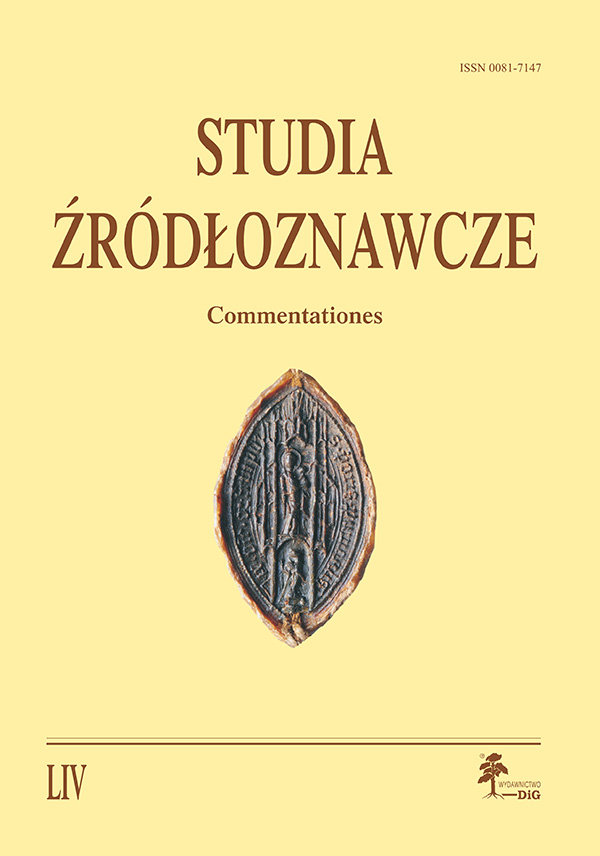Romanesque Embroidered Inscriptions on Silk Fabric Strips from Grave no. 24 in the Collegiate Church in Kruszwica
DOI:
https://doi.org/10.12775/SZ.2016.04Keywords
Romanesque epigraphy, Romanesque tomb textiles, Kruszwica, Notker BalbulusAbstract
The article is a philological analysis and an initial epigraphic analysis of inscriptions embroidered on silk fabric found in 1960 in tomb no. 24 in the Romanesque collegiate church in Kruszwica. The preserved three pieces of silk (two are of identical length and one is a fragment) originally constituted probably a single object with the inscriptions arranged most likely into a sequence with a cohesive meaning (on the function of this object cf. articles by E. Dąbrowska and M. Cybulska and E. Orlińska-Mianowska in this volume). A philological analysis of the inscriptions preserved on the longer pieces of fabric makes it possible to ascertain that they comprise rhythmic-versification units. Inscription no.1 is in so-called rich hexameter, while inscription no. 2 is an incipit of a hymn to The Holy Spirit, attributed to Notker the Stammerer (Balbulus) from St. Gallen. The fragmentary inscription no. 3., barely several letters long, poses the greatest interpretation problem owing to the state of its preservation, which (according to B. Kürbis, who witnessed its discovery) could have been quite different than its present-day version. For this reason it seems possible to decipher the fragment in question in two ways, and the place which inscription no. 3. could have originally held in the sequence of inscriptions remains of a closely connected question. An epigraphic analysis of the inscriptions written in Romanesque capitals with elements of the uncial indicates their imitative execution (i.a. an error in the word: spiritus in inscription no. 2), albeit with the use of rather sophisticated lettering (the letter P). The shapes of the signs permit a restricted establishment of the time of the origin of the inscriptions, since some occur in codex writing and epigraphic much earlier than could be the date of the strips of fabric from Kruszwica (A in: gracia from inscription no. 2). By referring to a typology of Romanesque epigraphic writing presented by Rudolf M. Kloos, codex and epigraphic comparative material (which should be considerably expanded) allows us to propose an approximate time of the origin of the inscriptions as not later than the second half or the end of the twelfth century, especially if the object to which the discussed inscriptions belong had been imported from the West.
References
Cherubini P., Pratesi A., Paleografia latina. L’avventura grafica del mondo occidentale, Città del Vaticano 2010 Ciechanowski K., Epigrafia romańska i wczesnogotycka w Polsce, Wrocław 1965
Clark J.M., The Abbey of St Gall as a Centre of Literature and Art, Cambridge University Press 1926 Favreau R., Épigraphie médiévale, Turnhout 1997
Gieysztor A., Zarys dziejów państwa łacińskiego, Warszawa 1973, wyd. 2, tamże 2009 Hoffmann H., Buchkunst und Königtum im ottonischen und frühsalischen Reich, Stuttgart 1986
Kloos R.M., Einführung in die Epigraphik des Mittelalters und der frühen Neuzeit, Darmstadt 1980 Knapiński R., Credo Apostolorum w romańskich Drzwiach Płockich, Płock 1992
Knight S., Historical Scripts from Classical Times to the Renaissance, New Castle, Delaware 1998
Płóciennik T., Kilka uwag na temat inskrypcji gnieźnieńskiej OSSA TRIUM..., w: Architektura romańska w Polsce. Nowe odkrycia i interpretacje. Materiały z sesji naukowej w Muzeum Początków Państwa Polskiego, Gniezno, 9–11 kwietnia 2008 roku, red. T. Janiak, Gniezno 2009, s. 661–667
Płóciennik T., L’épigraphie du tympan de Iaxa à Wrocław, „Cahiers de Civilisation Médiévale”, 40, 1997 Semkowicz W., Paleografia łacińska, wyd. 2, poprawione, Kraków 2002
Skubiszewski P., Le Règne, le Sacerdoce et la Salut. Un cycle d’images et son commentaire épigraphique sur le calice roman de Trzemeszno, w: Qu’est-ce que nommer? L’image légendée entre monde monastique et pensée scolastique. Actes du colloque du RILMA, Institut Universitaire de France (Paris, INHA, 17–18 octobre 2008), édités par Ch. Heck, Turnhout 2010
Trelińska B., Gotyckie pismo epigraficzne w Polsce, Lublin 1991
Downloads
Published
How to Cite
Issue
Section
Stats
Number of views and downloads: 396
Number of citations: 0



